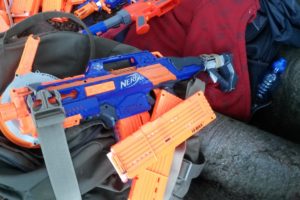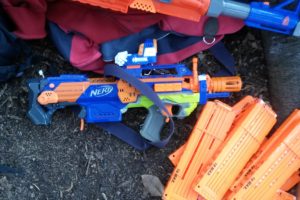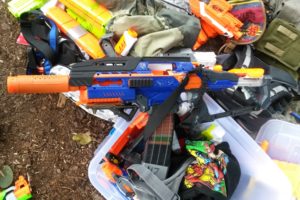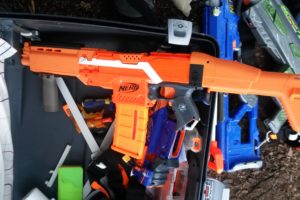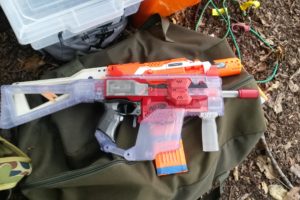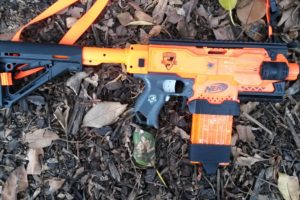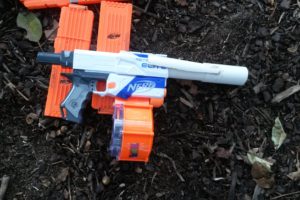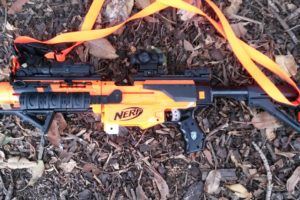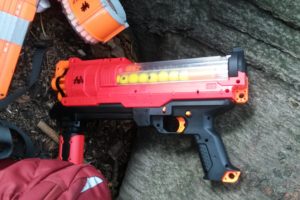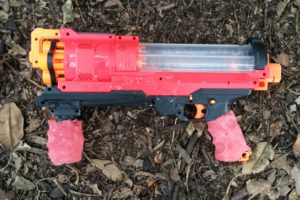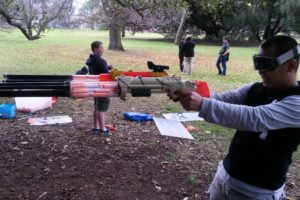
Nerf Game Report 8/7/17: Melbourne HvZ
July 13, 2017We had a great turnout at MHvZ today, which resulted in some rather impressive hordes. We also tried out some new gamemodes. This Nerf Game Report goes into particular detail about the new gamemodes.
Gamemodes:
Regular:
- (Regular) Survival – Standard HvZ gametype, humans try to survive for a given amount of time (or until the last human falls). Zombies are given access to upgrades at various times, we used Infectors at 5 minutes, Tanks at 10 minutes and Husk at 15 minutes. Last human to fall wins.
- Secret VIP – There are 3 special players in this game: the VIP, the General and the Traitor. The VIP is a human who the other humans are trying to protect and is restricted to a given area (we used the usual tambark area), while the Traitor is a zombie masquerading as a human. When stunned, zombies must move outside of the VIP’s area before counting down their stun. The only person who knows the VIP’s identity is the General, while all original zombies know the Traitor’s identity. Everyone knows the identity of the General, making them the only guaranteed trustworthy human. The Traitor acts as a human, but can at any point do a single Traitor zombie tag, revealing that they are the Traitor, and thus turning into a regular zombie. Additionally, if a human hits another human, the hit human is stunned as if they were a zombie, however they can still fire their blaster. If the humans protect the VIP for a given period of time (e.g. 15 minutes), the humans win. If the zombies successfully tag the VIP, the zombies win. Zombie upgrades are unlocked on a timer like Survival, with Infectors available from the start, 5 minutes for Tanks and 10 minutes for Husk. If a human is hit by a grenade, they are instantly turned into a zombie. This is the only way to actively eliminate the Traitor.
New/Infrequent:
- Zombie Payload – A zombie is designated as the “payload”, and carries a bucket as an indicator of this status. They cannot run, however otherwise behave as an ordinary zombie. The objective of the zombies is to escort their payload from the start area to the end zone. The humans will attempt to hold off the payload from reaching the end zone. If the payload reaches the end zone within 15 minutes, zombies win. If the payload does not reach the end zone by 15 minutes, humans win. Zombie upgrades are made available at 5/10 minutes ala Secret VIP.
- Bounty Hunt – Three humans are designated as VIPs, and allocated a particular zombie upgrade. If a VIP is tagged, their allocated zombie upgrade is made available. The game otherwise operates like a standard Survival round. In the second round of Bounty Hunt, a Traitor was added, operating on the same rules as in Secret VIP.
Zombie rules:
Zombies tag humans with their hands onto any body part, blaster, tactical gear, etc, turning the human into a zombie. If a human hits a zombie with a dart, the zombie is stunned for a count of 20. A human can also stun a zombie with melee, but only with a direct hit to the back.
There are 3 standard zombie upgrades/mutations/perks:
- Infector – zombies get to use foam swords, pool noodles, etc. Tags with said foam melee weapons on humans count as regular tags. Said melee weapons can also be used to block darts.
- Tank – zombies get to use shields, which block darts. The shields cannot be used to tag humans, presumably as a precaution against shieldbashing which could cause significant injury.
- Husk – a zombie gets to use a ranged attack, in this case a Zing bow. A ranged Husk attack counts as a regular zombie tag. The Husk may move from the place they were stunned to retrieve their ammo, but do not count down their stun timer until they return to their original stun place.
Zombie upgrades cannot be stacked, so a zombie can only have one upgrade at any time.
If in play, grenades can stun a zombie with a hit to a shield, and can be reused at will. If human vs human rules are in effect, a grenade hit to a human will turn that human into a zombie immediately.
Blasters:
Since there were a lot of different blasters there, I’ve generalised them and only listed down the ones that I saw as significant or noteworthy, or remember for that matter. Being that I can’t be everywhere at once, it’s entirely possible I completely missed some blasters. As there were a lot more players than usual, I quite possibly missed a lot more blasters in action.
Recurring/Regulars:
Elite Rapidstrike (various motors, LiPos) – standard high ROF blaster for MHvZ. Capable of excellent volume of fire at decent range, however requires good trigger control and a lot of ammo to keep in check.
Elite Stryfe (various motors, LiPos) – standard semi-auto flywheeler for MHvZ. Simple, dependable and very effective in the right hands, Stryfes are very popular for good reason.
 Mega Rotofury (rebarreled, various upgrade springs) – a fairly popular high-power blaster. When rebarreled for regular darts, the Rotofury can be very powerful, effective at flinging darts at mid-to-long range with the right darts. The Koosh darts we use at MHvZ do limit their usefulness at longer ranges a fair bit however, being rather unstable at such speeds and unfriendly to long barrels. Its relatively low ROF compared to most other popular blasters also makes them more vulnerable in close range or against multiple zombies.
Mega Rotofury (rebarreled, various upgrade springs) – a fairly popular high-power blaster. When rebarreled for regular darts, the Rotofury can be very powerful, effective at flinging darts at mid-to-long range with the right darts. The Koosh darts we use at MHvZ do limit their usefulness at longer ranges a fair bit however, being rather unstable at such speeds and unfriendly to long barrels. Its relatively low ROF compared to most other popular blasters also makes them more vulnerable in close range or against multiple zombies.
 ZS Slingfire (unknown mods if any) – a fairly standard manual-action mag-fed blaster. Outside of its main niche of being one-handable, it is largely outclassed by other, more popular options such as the Retaliator.
ZS Slingfire (unknown mods if any) – a fairly standard manual-action mag-fed blaster. Outside of its main niche of being one-handable, it is largely outclassed by other, more popular options such as the Retaliator.
Elite Retaliator (various springs, pump grips) – the most popular mag-fed springer at MHvZ. A solid, compact blaster with massive aftermarket parts support, capable of turning it from a large pistol into a fairly powerful pump action rifle blaster. It is beaten for power and ROF by a number of blasters, however in my opinion it is the most balanced springer that is readily available, at least in Australia.
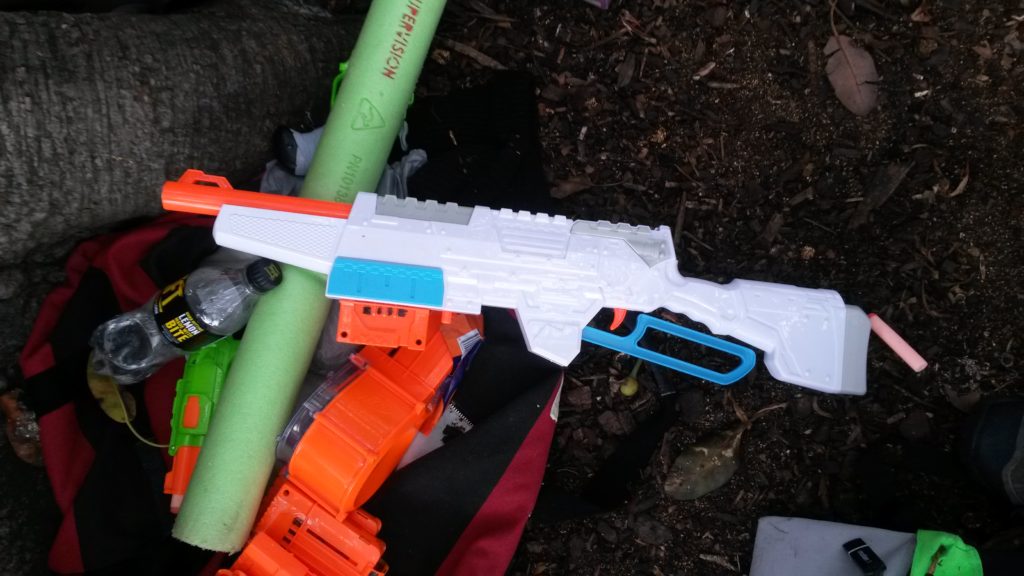 Buzz Bee Sentinel (unknown mods if any) – a lever-action blaster that is very powerful out-of-box. Compared to the Slingifre, it is much harder to one-hand prime, however packs a whole lot more power and is much more competitive with more popular blasters like the Retaliator. Its lever action does keep its ROF low however, making it much more difficult to use in close quarters, or against multiple zombies.
Buzz Bee Sentinel (unknown mods if any) – a lever-action blaster that is very powerful out-of-box. Compared to the Slingifre, it is much harder to one-hand prime, however packs a whole lot more power and is much more competitive with more popular blasters like the Retaliator. Its lever action does keep its ROF low however, making it much more difficult to use in close quarters, or against multiple zombies.
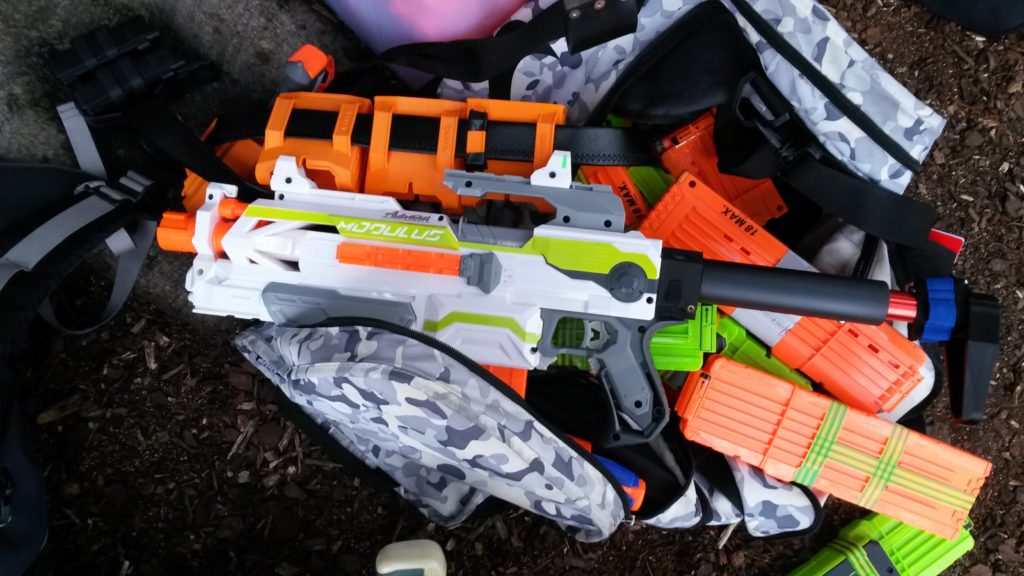 N-Strike Modulus (unknown mods, assumed overhaul) – essentially just a bulky Stryfe, with similar performance in a much larger shell. The handle is notably uncomfortable, however the battery tray in the foregrip provides a much larger space for a LiPo than the Stryfe.
N-Strike Modulus (unknown mods, assumed overhaul) – essentially just a bulky Stryfe, with similar performance in a much larger shell. The handle is notably uncomfortable, however the battery tray in the foregrip provides a much larger space for a LiPo than the Stryfe.
 Elite Rampage (unknown mods if any) – a solid mag fed blaster that is pump action out-of-box. Its main issue is the side magwell, which is rather unbalanced, unfriendly for left-handers, and a little awkward for maneuvering. It is a little behind the Retal for power, however I find the Rampage to be better for rapid-fire.
Elite Rampage (unknown mods if any) – a solid mag fed blaster that is pump action out-of-box. Its main issue is the side magwell, which is rather unbalanced, unfriendly for left-handers, and a little awkward for maneuvering. It is a little behind the Retal for power, however I find the Rampage to be better for rapid-fire.
 ZS Sledgefire (singled, upgrade spring) – a high power single-shot blaster. A fairly simple but fun and powerful blaster that is quite effective for mid-to-long range potshots. Its single shot nature makes it very vulnerable against multiple zombies and in close quarters combat.
ZS Sledgefire (singled, upgrade spring) – a high power single-shot blaster. A fairly simple but fun and powerful blaster that is quite effective for mid-to-long range potshots. Its single shot nature makes it very vulnerable against multiple zombies and in close quarters combat.
New/Infrequent:
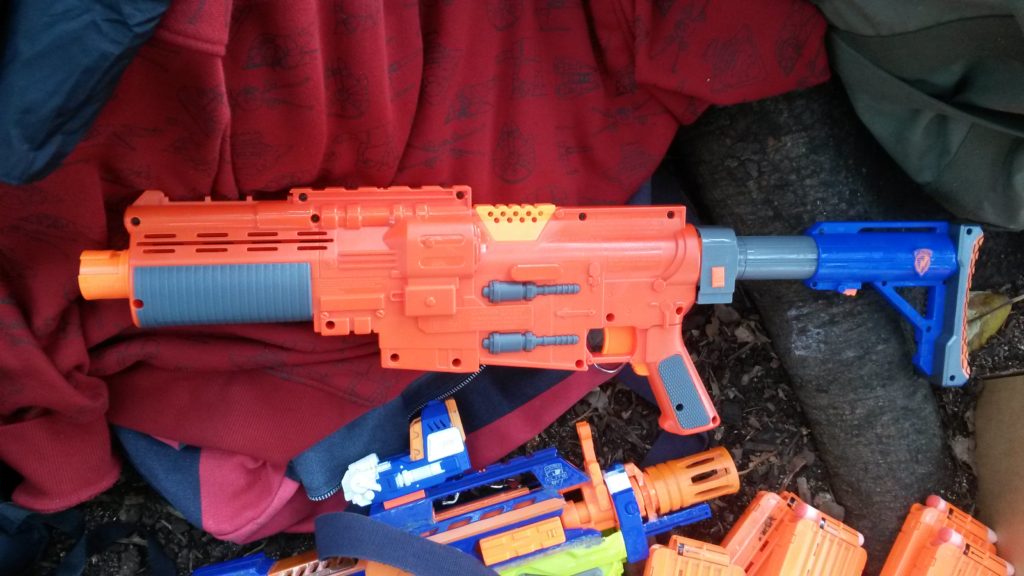 Jyn Erso Blaster (Meishel 2.0s, 2S LiPo) – brought this along to test out not only the Meishel 2.0s, but also the Jyn Erso blaster itself as a semi-auto flywheeler. Both performed acceptably, but not exceptionally. Meishel 2.0s are perfectly adequate as a 2S flywheel motor, with decent spin-up time, a good speed range and non-extreme current draw. I have no issues with them and would definitely recommend them for their intended role.
Jyn Erso Blaster (Meishel 2.0s, 2S LiPo) – brought this along to test out not only the Meishel 2.0s, but also the Jyn Erso blaster itself as a semi-auto flywheeler. Both performed acceptably, but not exceptionally. Meishel 2.0s are perfectly adequate as a 2S flywheel motor, with decent spin-up time, a good speed range and non-extreme current draw. I have no issues with them and would definitely recommend them for their intended role.
The Jyn Erso blaster performed about as expected, being noticeably but not unusably worse performance wise compared to my other flywheelers with aftermarket flywheels. It does have some notable usability issues that in my mind put it behind most of the other semi-auto flywheelers. Firstly is its somewhat awkward design, with a rather small handle and an awkwardly placed foregrip that make holding it a little uncomfortable. A particular issue I had was how easy it is to accidentally press the rev trigger due to the handle design and the significant front weight. Additionally, the magwell is rather tight, and this coupled with the right-side-only mag release can make it a little more difficult to change mags. This coupled with the front-heavy design made it much more awkward and difficult to switch mags compared to most other flywheelers. Finally, the Jyn Erso blaster is not compatible with F10555 Pmags due to the magwell area design, which I discovered to my dismay on the field.
Rival Artemis (assumed stock) – my first time seeing these in person, they are a very solid out-of-box Rival springer, and a pretty good stock blaster all round. Good capacity that is easily topped up on-the-fly (though difficult to fill from empty/near-empty), quite good stock range and accuracy as is expected from the Rival line, and pump action with slam-fire for a solid ROF. Compared to a typical overhauled Stryfe (or similar modded superstock blasters), the Artemis is a little outclassed, but for stock blasters, it’s certainly a very good one.
Air Zone Tripleshot/Lanard Shotgun (complete overhauls) – these things are absolute monsters, each with 3-dart inline clips for each barrel. The yellow one packs the standard 4 barrel arrangement of a typical “Quadshot” for a total capacity of 12 darts, while the beige one uses an 8 barrel arrangement for a total capacity of 24 darts. Packing an impressive amount of power, these things are capable of effective shots at ranges well beyond most other blasters, however were largely mitigated again by the use of Koosh, which are rather unstable and inaccurate at such speeds.
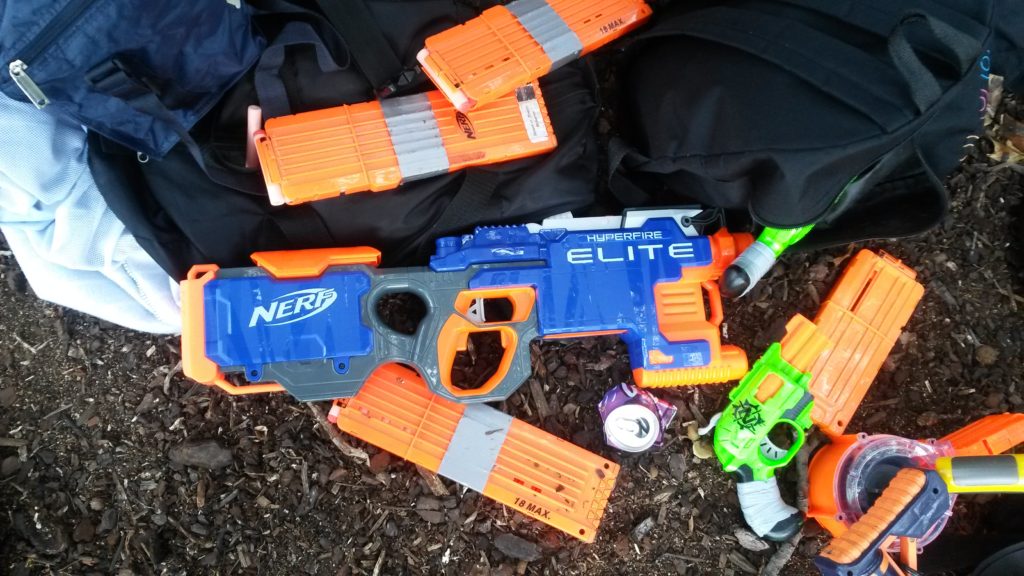 Elite Hyperfire (various, unknown mods if any) – generally speaking, in my opinion, a worse Rapidstrike. The stock canted flywheel cage presents a serious issue, at least with Koosh darts (which as mentioned are the dart of choice for MHvZ), with a much higher chance of spinning them out than a straight cage, though this is less of an issue at lower speeds. I found the belt feeding mech to be far less reliable than a pusher as well. That said, there aren’t many Hyperfires that see use at MHvZ, and those that do are rarely put through as comprehensive combat testing as Rapidstrikes often are.
Elite Hyperfire (various, unknown mods if any) – generally speaking, in my opinion, a worse Rapidstrike. The stock canted flywheel cage presents a serious issue, at least with Koosh darts (which as mentioned are the dart of choice for MHvZ), with a much higher chance of spinning them out than a straight cage, though this is less of an issue at lower speeds. I found the belt feeding mech to be far less reliable than a pusher as well. That said, there aren’t many Hyperfires that see use at MHvZ, and those that do are rarely put through as comprehensive combat testing as Rapidstrikes often are.
 Dart Tag Swarmfire (unknown mods if any) – a rather old, though still quite effective blaster. Provides fairly slow full-auto fire when stock, though packs a solid punch for a stock blaster. Its main draw besides easily upgradeable full-auto is its on-the-fly-reloadable 20 dart turret, which is a decent capacity, easily enough to fend off small groups of zombies. Though a pain to fill up when empty, the Swarmfire can be a novel and rather effective option as a non-mag-fed full auto blaster when modded.
Dart Tag Swarmfire (unknown mods if any) – a rather old, though still quite effective blaster. Provides fairly slow full-auto fire when stock, though packs a solid punch for a stock blaster. Its main draw besides easily upgradeable full-auto is its on-the-fly-reloadable 20 dart turret, which is a decent capacity, easily enough to fend off small groups of zombies. Though a pain to fill up when empty, the Swarmfire can be a novel and rather effective option as a non-mag-fed full auto blaster when modded.
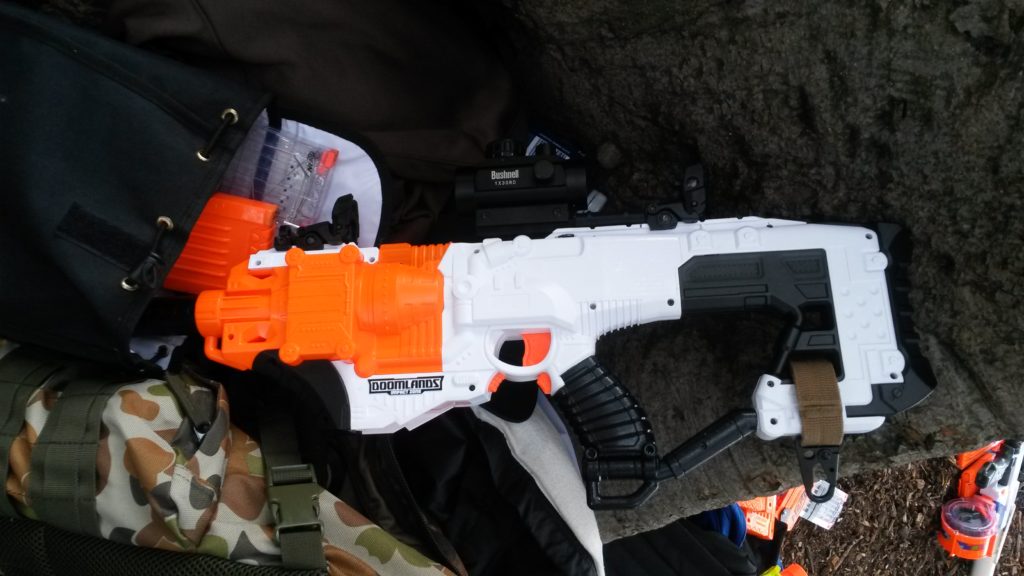 Doomlands Desolator (unknown mods, assumed overhaul) – as mentioned in previous posts, essentially just a Stryfe with a fancy body kit. A very solid all-round blaster.
Doomlands Desolator (unknown mods, assumed overhaul) – as mentioned in previous posts, essentially just a Stryfe with a fancy body kit. A very solid all-round blaster.
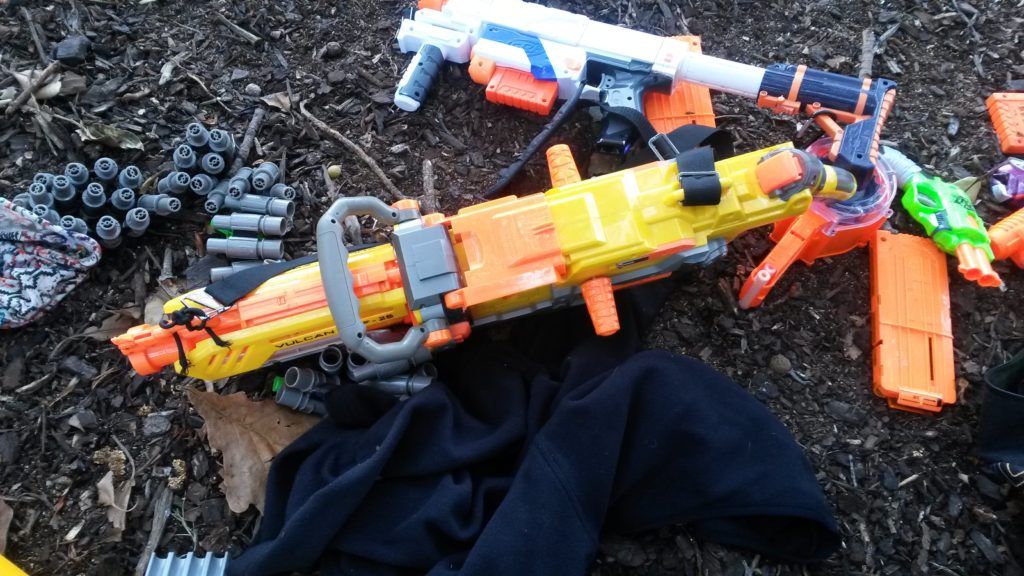 N-Strike Vulcan (unknown mods if any) – Used purely for cool factor rather than anything else, with its only notable feature being a higher-than-average capacity. Struggles compared to most other popular blasters without major work (usually involving a flywheel afterburner).
N-Strike Vulcan (unknown mods if any) – Used purely for cool factor rather than anything else, with its only notable feature being a higher-than-average capacity. Struggles compared to most other popular blasters without major work (usually involving a flywheel afterburner).
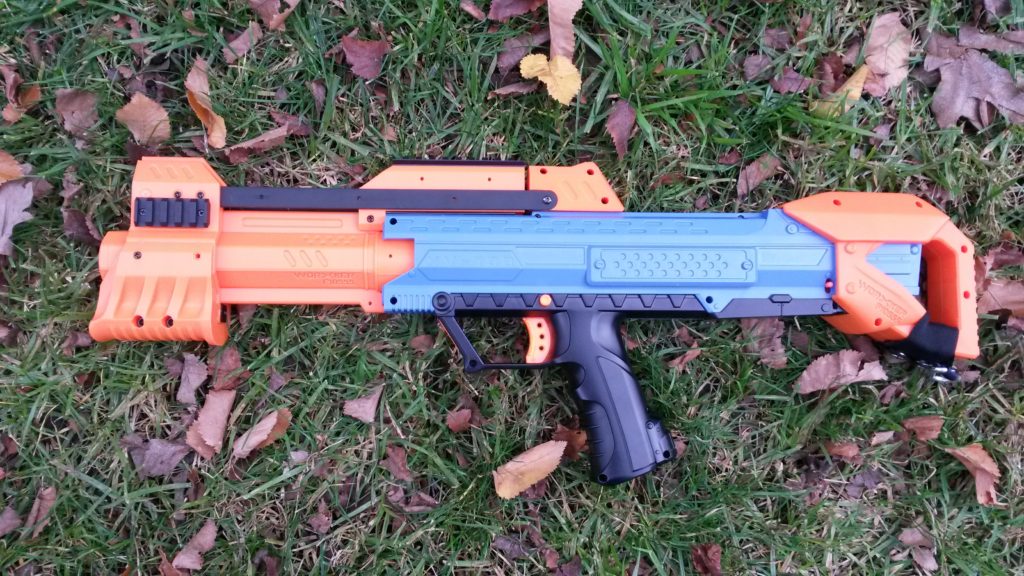 Rival Apollo (pump grip) – didn’t see any combat use, it’s just the first time I’ve seen an Apollo with a pump grip.
Rival Apollo (pump grip) – didn’t see any combat use, it’s just the first time I’ve seen an Apollo with a pump grip.
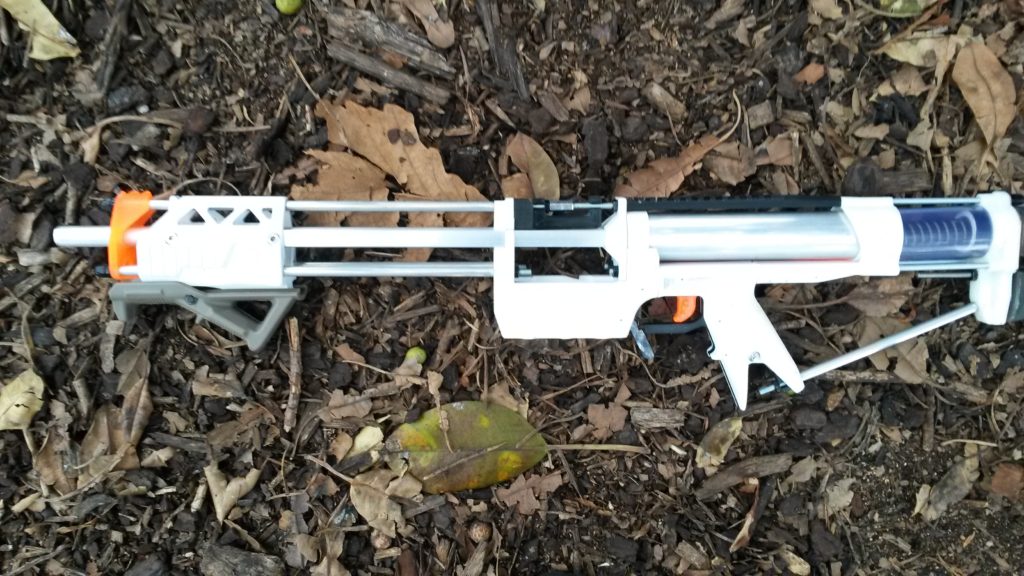 Caliburn (homemade blaster) – also didn’t see any combat use as it is far too powerful for MHvZ, but again included because I haven’t seen one before and it’s pretty cool.
Caliburn (homemade blaster) – also didn’t see any combat use as it is far too powerful for MHvZ, but again included because I haven’t seen one before and it’s pretty cool.
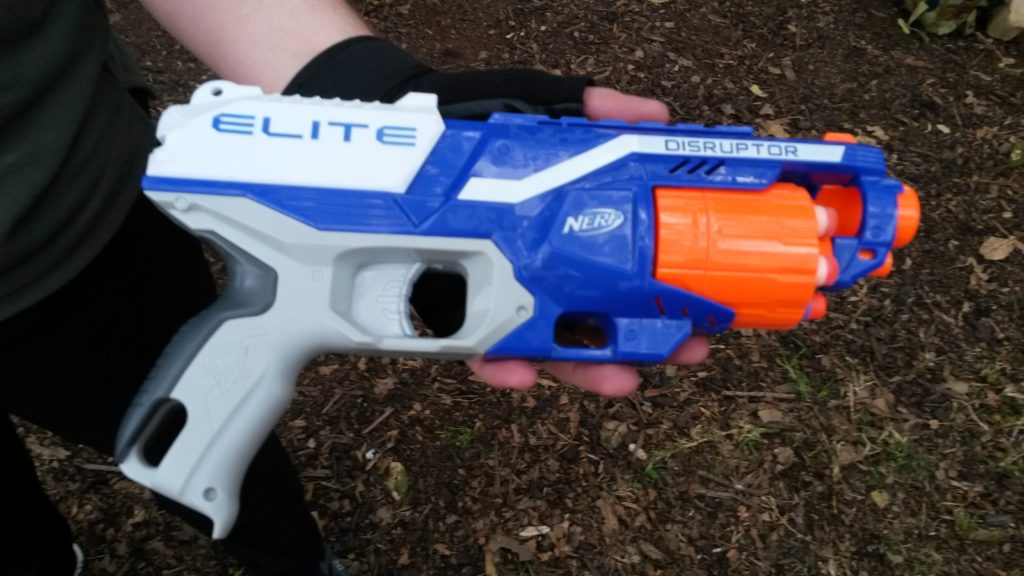 Elite Disruptor (upgrade spring) – essentially a Strongarm that is more convenient to reload, which in itself is still a very useful improvement. Works well as a sidearm blaster, with enough capacity, power, and a good enough ROF to fend off a few zombies quite comfortably.
Elite Disruptor (upgrade spring) – essentially a Strongarm that is more convenient to reload, which in itself is still a very useful improvement. Works well as a sidearm blaster, with enough capacity, power, and a good enough ROF to fend off a few zombies quite comfortably.
 Same play area as always, with all of the deciduous trees losing their leaves thanks to the winter. This resulted in some of the trees losing a lot of their effectiveness as cover. It was relatively cool, as is typical for a winter Melbourne day, with cloud cover but only the slightest hint of rain. We had a big turnout today, peaking at around 45 players, which is one of the highest, if not the highest, turnout I’ve seen.
Same play area as always, with all of the deciduous trees losing their leaves thanks to the winter. This resulted in some of the trees losing a lot of their effectiveness as cover. It was relatively cool, as is typical for a winter Melbourne day, with cloud cover but only the slightest hint of rain. We had a big turnout today, peaking at around 45 players, which is one of the highest, if not the highest, turnout I’ve seen.
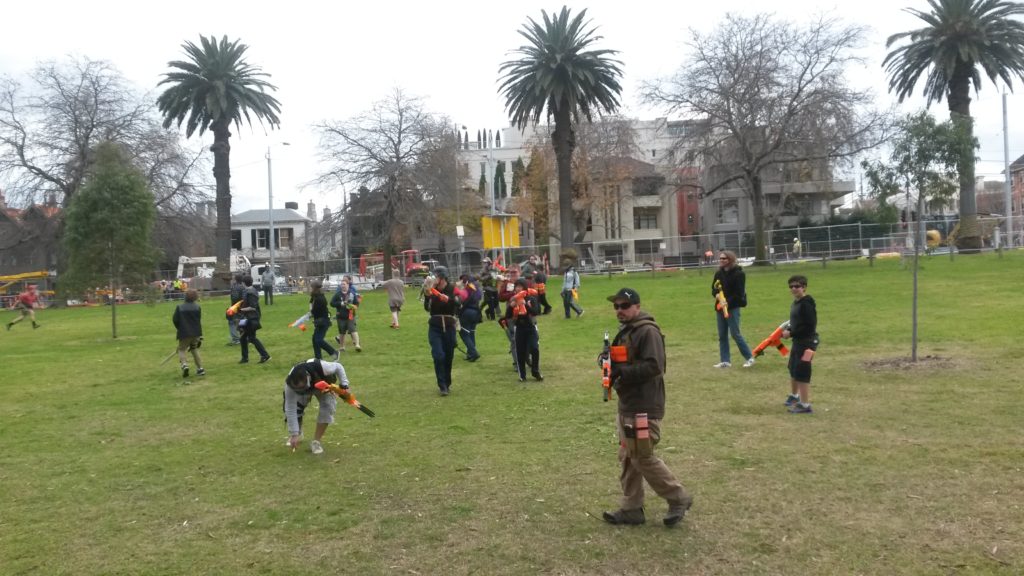 We started off the day with a standard Survival round. It played out as per usual for Survival, with the humans surviving with minimal losses until Tank shields were made available for the zombies. Tanks are by far the most effective tool that the zombies have for splitting up human groups, and smaller, isolated human groups (especially lone humans) are much easier for zombies to pick off. I was able to survive until the end of the game, primarily by avoiding the main human groups and their pursuing zombies. In this way I was usually only targeted by a small number of zombies at any one time, and very rarely drew the attention of the Tanks. With human numbers dwindling and the zombie horde growing to an impressive size, I inevitably became the target of many zombie attacks. I survived to be the last human standing, eventually dumping my now-empty Jyn Erso blaster and using up all the darts in my Sweet Revenges before being tagged.
We started off the day with a standard Survival round. It played out as per usual for Survival, with the humans surviving with minimal losses until Tank shields were made available for the zombies. Tanks are by far the most effective tool that the zombies have for splitting up human groups, and smaller, isolated human groups (especially lone humans) are much easier for zombies to pick off. I was able to survive until the end of the game, primarily by avoiding the main human groups and their pursuing zombies. In this way I was usually only targeted by a small number of zombies at any one time, and very rarely drew the attention of the Tanks. With human numbers dwindling and the zombie horde growing to an impressive size, I inevitably became the target of many zombie attacks. I survived to be the last human standing, eventually dumping my now-empty Jyn Erso blaster and using up all the darts in my Sweet Revenges before being tagged.
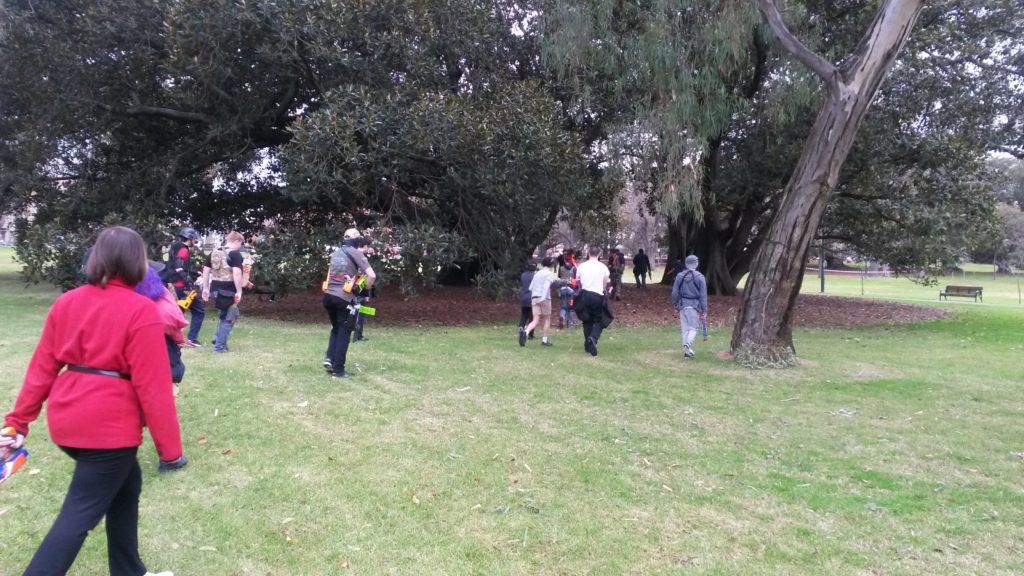 We played a round of Secret VIP afterwards. The early game progressed as per usual for Secret VIP, with the zombies getting few, if any tags in the first five minutes. The release of Tank shields allowed the zombies to more effectively push into the human’s tambark zone. Successive Tank charges yielded very good results for the zombies, often catching much of the human group off guard or forcing them to scatter, opening the door for opportunistic zombies to move in for some easy tags. The new Husk contributed a significant factor as well, being capable of tags from well behind the zombie ranks. These contributed to the human group dwindling rapidly in the last few minutes of the game. I was tagged near the end of the game during a moment of poor situational awareness, distracted by an incoming Tank. With less than ten humans remaining, the zombies were able to tag the VIP in one of their many charges, ending the game with a zombie win.
We played a round of Secret VIP afterwards. The early game progressed as per usual for Secret VIP, with the zombies getting few, if any tags in the first five minutes. The release of Tank shields allowed the zombies to more effectively push into the human’s tambark zone. Successive Tank charges yielded very good results for the zombies, often catching much of the human group off guard or forcing them to scatter, opening the door for opportunistic zombies to move in for some easy tags. The new Husk contributed a significant factor as well, being capable of tags from well behind the zombie ranks. These contributed to the human group dwindling rapidly in the last few minutes of the game. I was tagged near the end of the game during a moment of poor situational awareness, distracted by an incoming Tank. With less than ten humans remaining, the zombies were able to tag the VIP in one of their many charges, ending the game with a zombie win.
 A significant contributor to the zombies’ success was the effectiveness of their Tank charges, or conversely the inability of the human groups to combat them. In past Secret VIP rounds, a well coordinated human group could easily split up and force back a Tank charge while other nearby humans protect them from nearby zombies. In today’s round, a Tank charge was usually met with much of the human group running and scattering, completely breaking formation and defensive solidity. This not only gave the Tanks much more time in the tambark, but also far more opportunities for nearby zombies to take advantage of. All too often I would hear a commotion from a different side of the tambark, and turn to see a large group of humans all running from a lone Tank. The Tank would eventually be stunned of course, but the humans would end up scattered all over the place, often with many arcs uncovered. Any nearby unstunned zombie could (and often did) take advantage of this gap to nab an easy tag or two before inevitably being hosed down.
A significant contributor to the zombies’ success was the effectiveness of their Tank charges, or conversely the inability of the human groups to combat them. In past Secret VIP rounds, a well coordinated human group could easily split up and force back a Tank charge while other nearby humans protect them from nearby zombies. In today’s round, a Tank charge was usually met with much of the human group running and scattering, completely breaking formation and defensive solidity. This not only gave the Tanks much more time in the tambark, but also far more opportunities for nearby zombies to take advantage of. All too often I would hear a commotion from a different side of the tambark, and turn to see a large group of humans all running from a lone Tank. The Tank would eventually be stunned of course, but the humans would end up scattered all over the place, often with many arcs uncovered. Any nearby unstunned zombie could (and often did) take advantage of this gap to nab an easy tag or two before inevitably being hosed down.
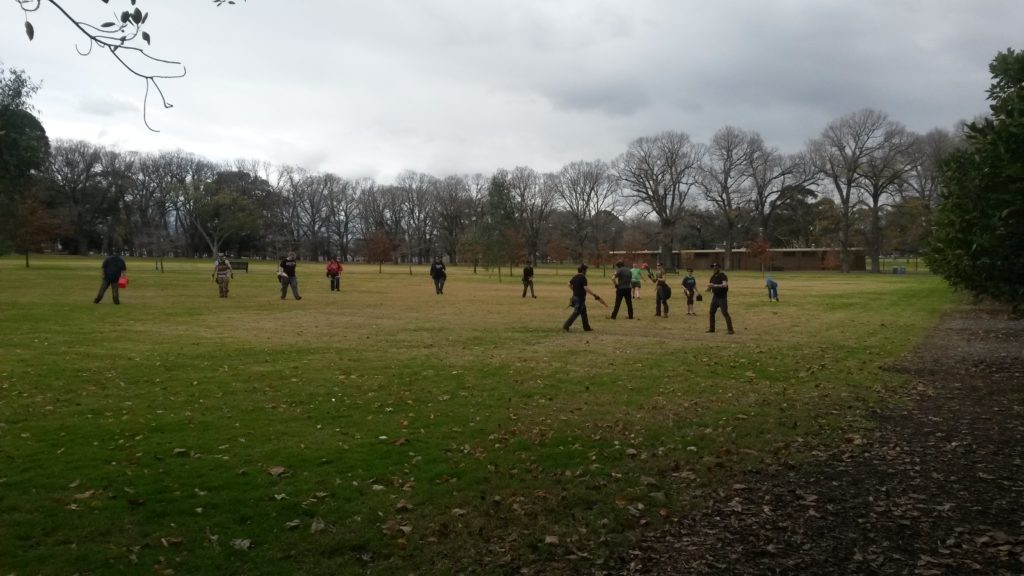 After the Secret VIP round, we began a new Six Dart Survival pickup gametype, however I personally have become severely disillusioned with the effectiveness and fun of such games. Several of us players have found it much faster and more effective to simply perform a proper pickup sweep, allowing for proper gametypes to be played more quickly. As such, while the other players were being briefed on this new gametype, we instead began to sweep up some of the lesser-explored areas of the play area. By the time this game started, we had finished sweeping the north-west corner, and had split up to cover the northern-most area and the western-most side. Once these sweeps were done, with the majority of the remaining darts in areas often occupied with players, I took an early lunch break.
After the Secret VIP round, we began a new Six Dart Survival pickup gametype, however I personally have become severely disillusioned with the effectiveness and fun of such games. Several of us players have found it much faster and more effective to simply perform a proper pickup sweep, allowing for proper gametypes to be played more quickly. As such, while the other players were being briefed on this new gametype, we instead began to sweep up some of the lesser-explored areas of the play area. By the time this game started, we had finished sweeping the north-west corner, and had split up to cover the northern-most area and the western-most side. Once these sweeps were done, with the majority of the remaining darts in areas often occupied with players, I took an early lunch break.
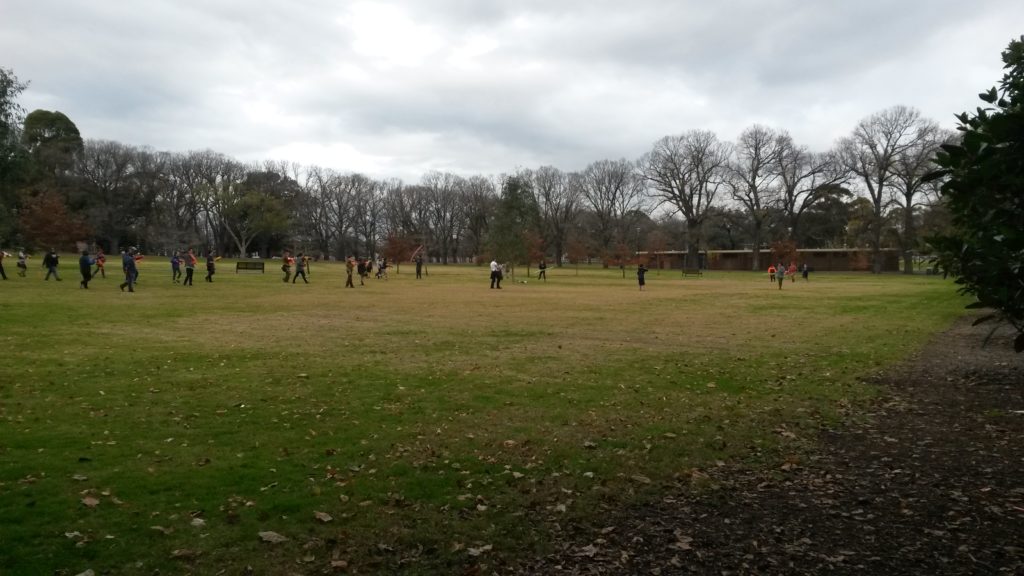 After the lunch break, we tried the new gamemode Zombie Payload. The zombies started in the southern most corner of the play area, with the end zone being designated as the central tambark area. The first couple of minutes were quite a mess. The zombies spent most of their time stunlocked by barrages of darts from an essential wall of death of humans, and with no way to avoid it. Any zombies who did manage to avoid the crossfire could do little to the humans, being hosed down by darts as soon as they approached. During this time, the Payload made slow progress, spending far more time being hit by darts than actually moving. While a few zombies may have achieved tags on unwary humans, for the most part the zombies made very little progress, much like in most other gametypes. Naturally that changed when zombies were given access to Tank shields at the five minute mark.
After the lunch break, we tried the new gamemode Zombie Payload. The zombies started in the southern most corner of the play area, with the end zone being designated as the central tambark area. The first couple of minutes were quite a mess. The zombies spent most of their time stunlocked by barrages of darts from an essential wall of death of humans, and with no way to avoid it. Any zombies who did manage to avoid the crossfire could do little to the humans, being hosed down by darts as soon as they approached. During this time, the Payload made slow progress, spending far more time being hit by darts than actually moving. While a few zombies may have achieved tags on unwary humans, for the most part the zombies made very little progress, much like in most other gametypes. Naturally that changed when zombies were given access to Tank shields at the five minute mark.
With Tanks, the zombies could actually threaten and push back the humans, nabbing many more tags while also clearing the way for the Payload to move forward. They could easily and effectively scatter the human groups, clearing the way not only for the Payload to move forward, but also for other zombies to make some easy tags. They also drastically reduced the effectiveness of the human wall of death formation. With Tanks in play, the Payload had a much easier time moving forward. Between the always dangerous Tanks and ever-growing zombie horde, it became increasingly difficult for humans to get near enough to the Payload to stun them. Couple that with the relatively short distance between the start area and end zone, and a zombie victory was all but inevitable. The last minutes of play saw the humans pushed further and further away from the Payload, leaving them clear to move to the end zone.
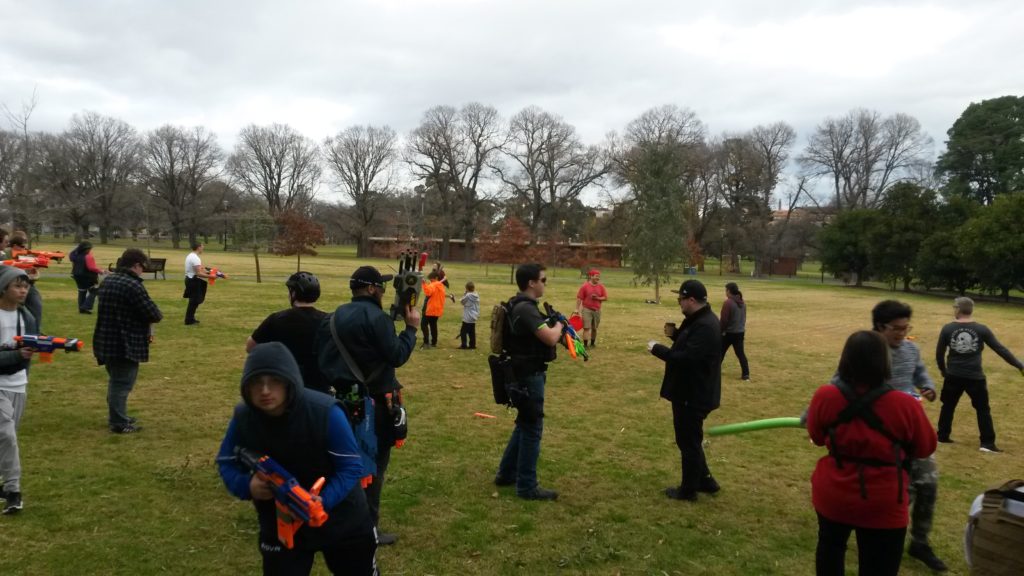 I personally didn’t like this gamemode. It heavily promotes stunlocking of zombies, which I personally do not particularly enjoy, either as a human or zombie. Unlike Defence Survival however, which also promotes stunlocking, Zombie Payload does not have any limit to how far a zombie can “creep” forward towards an objective. In Defence Survival, zombies are limited by having to unstun outside of the Defence squares, being unable to creep any closer than about 2m from the zombie upgrades. In Zombie Payload, there is no such limitation, and as such, the Payload can creep forward slowly even with near-constant stunning from guarding humans. There is no way for the humans to reliably slow down or stop the Payload short of a constant barrage of darts, which I consider to be very boring and un-fun for both sides.
I personally didn’t like this gamemode. It heavily promotes stunlocking of zombies, which I personally do not particularly enjoy, either as a human or zombie. Unlike Defence Survival however, which also promotes stunlocking, Zombie Payload does not have any limit to how far a zombie can “creep” forward towards an objective. In Defence Survival, zombies are limited by having to unstun outside of the Defence squares, being unable to creep any closer than about 2m from the zombie upgrades. In Zombie Payload, there is no such limitation, and as such, the Payload can creep forward slowly even with near-constant stunning from guarding humans. There is no way for the humans to reliably slow down or stop the Payload short of a constant barrage of darts, which I consider to be very boring and un-fun for both sides.
For Payload type gamemodes, I feel that there needs to be a way for the Payload to be completely and reliably stopped. More importantly, they should also be stoppable without resorting to mindless or overkill tactics such as constant dart hosing, which to me suggests poor game design. The Payload itself should not be able to slowly inch forward of its own accord, certainly not still while confronted with a large group of humans. Rather, a Payload more akin to the Bomb in the old Blind Bomber gamemode (a separate game piece that is carried by a human), or even just more like Payloads in shooter games (think Overwatch or TF2, Payloads that only move when members of the appropriate team are nearby) would make for a much more competitive and fun game. Of course a lot of alteration would be necessary to make a Zombie Payload gametype work, given the drastic imbalance in teams, but I do not think the gametype currently is competitive or fun.
 After the Zombie Payload round, we tried two rounds of Bounty Hunt. The first round of Bounty Hunt did not have a Traitor, while the second round did.
After the Zombie Payload round, we tried two rounds of Bounty Hunt. The first round of Bounty Hunt did not have a Traitor, while the second round did.
The game progressed much the same as a normal Survival round, just with the zombies more focused on the VIPs instead of targeting whichever human group they felt like. In turn, the humans were also grouped a little more tightly than usual, with more focus of actually protecting a particular human rather than just survival. Once all the VIPs were tagged and all the upgrades made available (in particular Tank shields), the game turns into just a standard Survival round. The difference is all in the mid-game, in how and when the zombies acquire the upgrades.
In the first round, although the Infector VIP was tagged relatively early, the zombies generally struggled to make much impact on the human groups. Although I wasn’t paying attention to the time, I’m fairly sure the zombies didn’t get access to Tank shields until well after 10 minutes of game time. Even when they did get access to Tank shields, I believe it was due to a miscommunication as I know the Tank VIP was still alive at that time. What this highlighted though was the need for the zombies to have some kind of “bunker buster” that wasn’t just Tanks for this gametype. In most games, the zombies can rely on getting access to Tank shields at some point during the game. This gives them a relatively reliable method of scattering and disrupting most human groups. In Defence Survival, though acquisition of the Tank shields is not guaranteed as such, it is near guaranteed that at some point the humans defending the Tank square with have a lapse of concentration, giving a zombie the opportunity to dive in and grab a shield.
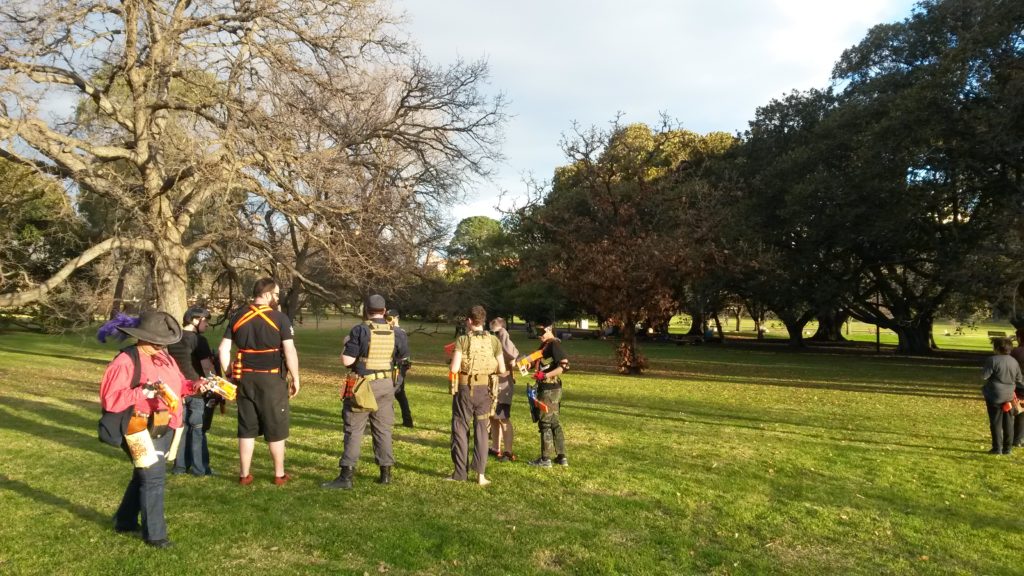 In Bounty Hunt, since the upgrades are tied to particular human players, it is possible that the zombies may never get access to a particular upgrade. If a VIP is the last survivor, the zombies will never get access to that upgrade during that round. This leads to a potential problem – if the Tank VIP is particularly good or lucky, the zombies may not get access to Tank shields until very late in the game – if they even get them at all. This can drag out the game for a very long time. As has been written about many times, Tank shields are central to the zombies’ ability to threaten the larger groups of humans. Without Tanks, the zombies often struggle to make any impression on large human groups, as they are far too easily hosed down if they get too close. As such, I felt that in Bounty Hunt, the zombies should have some other method of human group disruption to compensate for the no longer guaranteed Tank shields. I suggested the implementation of a Traitor, which was implemented in the second round.
In Bounty Hunt, since the upgrades are tied to particular human players, it is possible that the zombies may never get access to a particular upgrade. If a VIP is the last survivor, the zombies will never get access to that upgrade during that round. This leads to a potential problem – if the Tank VIP is particularly good or lucky, the zombies may not get access to Tank shields until very late in the game – if they even get them at all. This can drag out the game for a very long time. As has been written about many times, Tank shields are central to the zombies’ ability to threaten the larger groups of humans. Without Tanks, the zombies often struggle to make any impression on large human groups, as they are far too easily hosed down if they get too close. As such, I felt that in Bounty Hunt, the zombies should have some other method of human group disruption to compensate for the no longer guaranteed Tank shields. I suggested the implementation of a Traitor, which was implemented in the second round.
The idea behind using a Traitor as a “bunker buster” in Bounty Hunt is that it guarantees the zombies at least one of the upgrades, ideally the Tank shields. In the second round, it was in fact not the Traitor, but poor situational awareness, that got the Tank VIP tagged. The zombies focused their efforts on the human group with the Tank VIP, and were eventually rewarded when the Tank VIP strayed too close to zombies coming to the end of their stun time. A Traitor is quite a sub-optimal solution for Bounty Hunt however. In Secret VIP, a Traitor prevents the VIP from being too open about their identity, and introduces some paranoia and discord into the human group. This works for Secret VIP because of the anonymity of the VIP, the short round timer and the relative safety of the VIP’s tambark zone. In Bounty Hunt, the three VIPs are known to everyone and this automatically makes them prime targets. It is not unreasonable for the Traitor to stick with the Tank VIP, and immediately tag them at the start of the game. This is rather un-fun for both the Tank VIP and the human group, as the humans have no real way of stopping this short of an exclusion zone around each VIP. I do not know what would make a better “bunker buster”, however I believe that with a suitable special zombie, Bounty Hunt could become a solid staple of MHvZ, like Defence Survival.
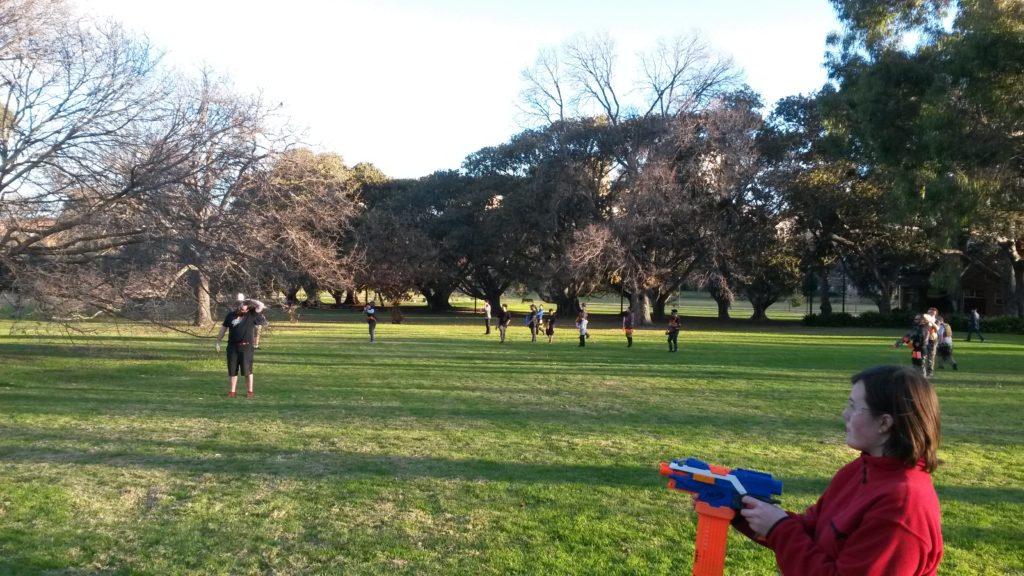 I would like to also discuss the Zing Bow Husk that was used in this event. In the most recent set of events, the Husk has been equipped with a single Vortex Mega Howler. I believe that the Husk is meant to keep humans on their toes, and serve primarily to distract/disrupt the humans. It should be effective against humans who not wary, however it should not be very effective in direct combat. The Husk should not be a direct threat to humans in the same way Tanks are, or a blaster would be. I consider the Vortex Mega Howler Husk to be the best implementation so far. It is quite obvious, both on the field and in flight. With a good throw, it can travel quite far with surprising accuracy. It is very difficult to hit an alert human with it, given its travel time and loud whistling noise, however it can easily draw the attention of humans and help to dirsupt human formations. In direct combat, the Vortex Mega Howler is not particularly effective as it is difficult to get a good throw off while under fire.
I would like to also discuss the Zing Bow Husk that was used in this event. In the most recent set of events, the Husk has been equipped with a single Vortex Mega Howler. I believe that the Husk is meant to keep humans on their toes, and serve primarily to distract/disrupt the humans. It should be effective against humans who not wary, however it should not be very effective in direct combat. The Husk should not be a direct threat to humans in the same way Tanks are, or a blaster would be. I consider the Vortex Mega Howler Husk to be the best implementation so far. It is quite obvious, both on the field and in flight. With a good throw, it can travel quite far with surprising accuracy. It is very difficult to hit an alert human with it, given its travel time and loud whistling noise, however it can easily draw the attention of humans and help to dirsupt human formations. In direct combat, the Vortex Mega Howler is not particularly effective as it is difficult to get a good throw off while under fire.
The Zing Bow is also capable of quite good range and accuracy. Compared to the Vortex Mega Howler however, Zing arrows are much less obvious and much more effective as a ranged weapon. They are much smaller and produce a much quieter whistling noise. Zing arrows also travel significantly faster, and with multiple arrows available, can be reloaded and fired again very quickly, making the Zing Bow much more effective in direct combat. This effectiveness as a ranged weapon overall is my biggest problem with the Zing Bow as a Husk weapon. While the zombies having a ranged weapon is not a problem in itself, the Zing Bow is too effective a weapon and blurs the distinction between humans and zombies too much. Past Husks such as the Vortex Mega Howler, and various rocket launchers, have worked as Husk weapons because they do not compete with human armament for ranged combat, and when pitted directly against most blasters, will not fare well. This is not the case for the Zing Bow, which has the range, accuracy and refire rate to compete with blasters, at least far better than the other Husks. As such, I believe that the Zing Bow is not suitable for Husk use, or at least not the Husk as it is implemented at MHvZ.
I quite enjoyed today’s event, a lot of players made for some rather intense Survival games and quite a claustrophobic mess in Secret VIP (as intended). I think Zombie Payload needs a lot of work to be a good gametype, and Bounty Hunt could do with some kind of new zombie in lieu of Tank shields not being guaranteed.
You can find the same post on my own blog: Outback Nerf
